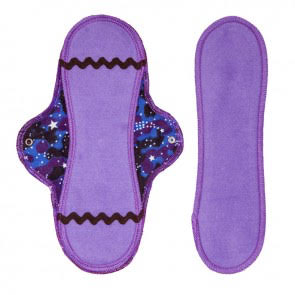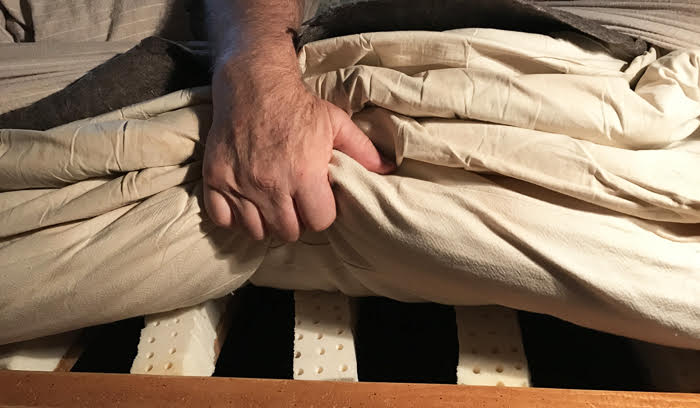
Art | Resources
Rhythm Superfoods
 This company makes delicious snacks out of organic lakato kale, broccoli, or beets. I’ve tried their beet chips and broccoli bites. They are delicious. What makes them super good for me is that the beet chips have no oil, just plain beets and nothing else, yet they are sweet and very crunchy (you can also get them with sea salt). The other snacks are flavored with various seasonings, seeds, and nuts. If you are going to eat a snack, this one is about as good as it can get.
This company makes delicious snacks out of organic lakato kale, broccoli, or beets. I’ve tried their beet chips and broccoli bites. They are delicious. What makes them super good for me is that the beet chips have no oil, just plain beets and nothing else, yet they are sweet and very crunchy (you can also get them with sea salt). The other snacks are flavored with various seasonings, seeds, and nuts. If you are going to eat a snack, this one is about as good as it can get.
Lunapads
 GOTS certified organic cotton menstrual pads and panty liners. Nice colors and patterns. Many sizes, styles, and absorbencies, and lots of information on how to make the switch and use.
GOTS certified organic cotton menstrual pads and panty liners. Nice colors and patterns. Many sizes, styles, and absorbencies, and lots of information on how to make the switch and use.
Cedar Key Canvas
 This small cottage industry has been making purses, totes, luggage, backpacks and duffles from heavy cotton canvas since 1986. Each piece you order is made especially for you in the style and color you choose and can be customized. They will also make your own fabric into a bag of your choice.
This small cottage industry has been making purses, totes, luggage, backpacks and duffles from heavy cotton canvas since 1986. Each piece you order is made especially for you in the style and color you choose and can be customized. They will also make your own fabric into a bag of your choice.
Radius
 A line of organic and natural dental products, including USDA certified organic toothpaste, silk dental floss and eco-friendly toothbrushes. “Our Radius USDA Organic 100% biodegradable Silk Floss is spun from the finest grade silk and dipped in 100% pure, natural candelilla wax which is a plant based wax. The end result is the most natural floss available on the market today. Silk was the original material used for all flosses throughout the world until the late 1930s when silk sources to the Western world were cut off due to the sino-Japanese War. Silk is an all-natural alternative to nylon.“
A line of organic and natural dental products, including USDA certified organic toothpaste, silk dental floss and eco-friendly toothbrushes. “Our Radius USDA Organic 100% biodegradable Silk Floss is spun from the finest grade silk and dipped in 100% pure, natural candelilla wax which is a plant based wax. The end result is the most natural floss available on the market today. Silk was the original material used for all flosses throughout the world until the late 1930s when silk sources to the Western world were cut off due to the sino-Japanese War. Silk is an all-natural alternative to nylon.“
The Goldilocks Effect—How Adding a Layer of GOLS-Certified Organic Latex Made My Bed “Just Right”
My multi-layered bed: wood slats with GOLS-certified organic latex strips, three organic wool toppers, organic wool felted wool pad.
I’m writing this because last Tuesday morning—before going off on an overnight trip—I glued some strips of GOLS-Certified Organic Latex to the wood slats on my bed frame.
I’ve had these latex strips sitting in their shipping box for a few months waiting for a day when I could let the glue dry overnight. Either I had to go sleep somewhere else, or I had to sleep on the floor. So I waited until I was going somewhere.
When I came home the next evening, I put my wool mattress and three wool toppers from Shepherd’s Dream back on the bed, and laid down. Immediately I said, “This feels wonderful!”
I had probably the best night’s sleep that night. Ever. And every night since I’ve slept really deeply all through the night. And Larry too. Sleeping like a baby.
I can only come to one conclusion: Like Goldilocks, I finally got my bed “just right.”
39 Years of Natural Beds
I’ve been sleeping on natural beds for almost forty years. I was committed to sleeping on a nontoxic mattress, but they were not always the most comfortable.
In 1978, my first nontoxic bed was a metal foldaway cot frame (with springs) on which I piled a stack of folded cotton thermal blankets. Not comfortable at all but it wasn’t toxic, so I slept better.
Then I got a cotton futon and slept on it on a wood floor. VERY uncomfortable, but it wasn’t toxic.
Then I got my first wool mattress, which was up on wood slats. Much more comfortable, but that was before it was discovered that a thick wool mattress wasn’t the best design because it couldn’t breathe. The cotton cover molded and disintegrated within a couple of years.
And then my next mattress was the Shepherd’s Dream wool mattress that I still sleep on today. And I have to say, after all these years it’s still like new.
At first I had it on the wood slats, but it’s not very thick, so I could feel the slats. I added two wool toppers and that was a lot better. (Later I added a third wool topper after purchasing one when I was out of town and needing to sleep on a synthetic mattress. When I got home, I just put it on my at-home mattress.)
Then Shepherd’s Dream introduced latex strips for the wood slats. I was reluctant to try them because I didn’t like the smell of latex.
At the time the only latex you could get was a mix of natural and synthetic. It smelled very strongly of what I used to call “latex smell” and I had to air the strips for several months before I could have them in the bedroom.
And then they just got to a point last October where they were crumbling and I had to take them off because they were creating piles of dust under the bed.
When I removed the strips, just having the mattress on the wood slats was less comfortable.
I really needed some new latex strips.
GOLS-Certified Organic Latex
I was reluctant to replace my latex strips because I really really really didn’t like the smell of what I thought was latex.
And then the folks at Happsy sent me a sample of their GOLS-certified organic latex. It is completely different from the natural/synthetic latex I had before.
I had assumed the odor I didn’t like was the natural odor of latex. Not so! The odor I didn’t like is completely absent from the GOLS-certified organic latex, so it must have been the synthetic latex I was objecting to.
But the best part is this latex is both nontoxic and comfortable. It is both soft and supportive at the same time.
It took me more than thirty years to get my “just right” bed. Part of the wait was that the materials just weren’t available before. But now we have a whole new generation of mattresses available with ever-improving materials.
I really didn’t know before this week how much difference a comfortable mattress makes in quality of sleep. Now I know. Amazing.
Costco is Starting To Screen for Toxics

Safer Chemicals, Healthy Families “Mind the Store” campaign announced last week that Costco has started a “Smart Screening” program to address toxic chemicals in some of the products they sell.
As a Costco member, I’m very happy to hear this. Living where I do, Costco is one of the few places where I can buy organic food, and I greatly appreciate the number of organic choices they have for frozen fruits and vegetables. It would be great to see more nontoxic products there.
“According to Costco’s website, the company is now testing some products for certain toxic chemicals of “regulatory and social concern,” and keeping products containing other harmful chemicals off store shelves entirely. This is a good first step toward tackling toxic chemicals! ”
You can read all about it in their new blog post.
SAFER CHEMICALS HEALTHY FAMILIES: Costco Starting to Take Stock of Toxic Chemicals
New EWG Report Warns PFCs Pollute Tap Water for 15 Million People
PFCs are highly toxic fluorinated chemicals that have been linked to cancer, thyroid disease, weakened immune systems and other health problems.
New research done by Environmental Working Group and Northeastern University in Boston have found PFC pollution in tap water supplies across America.
Check their interactive map to see if your water supplies are contaminated.
IF YOU HAVE PFCs IN YOUR WATER…
According to the American Water Works Association (a non-profit, scientific educational association established in 1881), activated carbon is very effective at removing over 90% of PFCs from the water supply.
Most water filters employ just 1 type of regular activated carbon, however, PureEffect Advanced Filtration Systems water filters (the filters I have been using and recommending for more than five years) have 3 different types of the Advanced Catalytic Activated Carbon in each of their 2, 3 and 4 chamber countertop/undercounter filter systems. This results in a superior range, capacity and thoroughness for PFC and other chemical removal.
The Case Against Fragrance
Question from Maureen
Hi Debra,
I am a regular reader of your site and just heard about a book you may be interested in…
The Case Against Fragrance by Kate Grenville.
Thanks for all you do to keep us healthy!!
Debra’s Answer
 Thanks so much for telling me about this book.
Thanks so much for telling me about this book.
I bought a copy and I have to say…
Wow! Everyone interested in fragrance issues should read this. It addresses the issue from every direction, is well documented, and it’s easy to read. If you want to explain to anyone what the problem is with fragrance, just have this book on hand.
The only thing missing is that it doesn’t tell you how to live fragrance-free.
But it does give all the documentation about WHY we need to watch out for fragrance.
What is Polyresin?
Question from Ronda
Hi Debra,
I was looking for lamps and found a lot of them to be poly resin. Some of what I read seems to say that this material is not toxic. Another article said it is toxic. Do you have an opinion on this? Thanks for all of the work you do to help families be safe!
Debra’s Answer
This is a difficult question to answer as there isn’t much information available.
A polyresin is a synthetic resin made from some petrochemical that has other materials added to it. One example is synthetic resin combined with ground alabaster, a natural stone.
Because the formulas for polyresins can vary so widely and as consumers it’s impossible for us to find out what the material actually is with today’s labeling, I would say the most prudent thing to do is avoid it because it’s an unknown.
However, at the same time, the fact that it is a HARD resin means that it is unlikely to outgas.
Use your best judgement. I can’t confirm it’s safe or toxic.
Simple Tips to Protect Your Body From Being Eaten by Mosquitoes

Dealing with mosquitoes is a natural part of summer, especially here in Florida. West Nile Virus aside, they are simply annoying as well having an itchy bite.
In times past, some very natural strategies were employed for mosquito relief. When I visited Charleston, North Carolina a some summers ago, I learned that all the old houses had the bedrooms on the second floor because mosquitoes wouldn’t fly that high. In Africa, whole cities are built up mountain sides “above the mosquito line.”
If you can’t move your bedroom upstairs or move your house up a mountain, here are some easier—completely natural—-things you can do to protect your body from mosquitoes this summer.
1. Make Your Body Less Attractive to Mosquitoes
Mosquitoes are attracted to our bodies through the carbon dioxide (CO2) we exhale when we breathe. The production of CO2 production varies from body to body based on its metabolic rate; those bodies with high metabolism tend to burn more CO2 and are therefore more attractive to mosquitoes.
They also like diabetics.
But they are also attracted to lactic acid, which our bodies release after a workout or after eating salty and high-potassium foods, and fruity and floral fragrances found in perfumes and bodycare products, scented sunscreens, and fabric softeners and dryer sheets.
Mosquitoes prefer moist, cool bodies, wet from rain, perspiration or swimming.
And if you are wearing light-colored clothing, particularly yellow, a mosquito will zoom right in on you.
So, to make your body unattractive to mosquitoes:
• eat less salt
• use unscented products
• dry off your body
• avoid sweets
• wear dark colors
2. Use Natural Repellents
If you want to use a repellent on your skin, the simplest repellant is vinegar. I learned this from an Italian woman who got this piece of wisdom from her grandmother. And it works! Any type of vinegar will do. I use apple cider vinegar, but cheap distilled white vinegar will do. I put it into one of those oil-and-vinegar shaker bottles usually used for salad dressing and keep it on my nightstand all summer. Before going to sleep, I just sprinkle it on my face and arms–especially around my ears–which generally does the trick.
There are also repellents made from fragrant essential oils, which are sold at many natural food stores and online. Most contain oil of citronella and/or oil of peppermint as the active ingredient. The U.S. Centers for Disease Prevention and Control recommend oil of lemon eucalyptus as an effective mosquito repellent.
Mosquitoes also hate the smell of garlic. Eat raw garlic or crush a clove and rub it on your skin.
Other good repellants include:
• clove essential oil
• vanilla extract
• citronella essential oil or live plants
• any kind of mint essential oils or live plants
• rosemary essential oil or live plants
• lemongrass
• marigolds
• Cuban oregano
• eucalyptus
You can grow many of these plants in your garden or in pots on a patio or balcony. I always have mint in my garden and I’m going to plant more.
3. Put Up a Barrier
The simplest barrier is to simply cover your skin with clothing. Long pants and shirts with sleeves offer good protection.
Be sure to put screens on your windows and doors and make sure they are in good repair. Open and close doors quickly so insects don’t come inside.
And there is always the traditional mosquito netting. Larry and I don’t have one on our bed here in Florida, but we did when we lived in California. I always felt safe and protected under the net. You can get 100% cotton mosquito netting by the yard online and make your own mosquito net.
4. Natural Treatments for Mosquito Bites
If, after all the prevention, you still get bitten, here are some natural ways to relieve the itch.
• Make a paste of water and baking soda and put it on your bites.
• Apply salt water made with natural salt–the water will evaporate and the soothing salt will stay on your skin.
• Rub raw garlic over the bites.
• Apply aloe vera to the bites, in gel form or straight from the plant.









